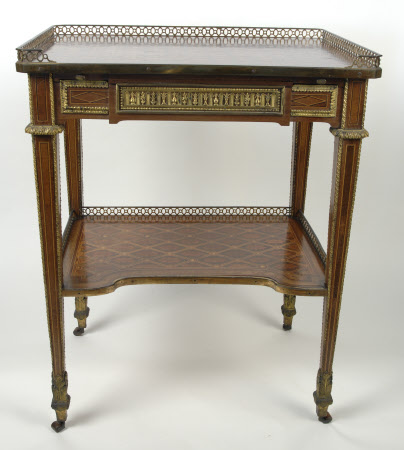Writing table
manner of Louis-Auguste-Alfred Beurdeley (Paris 1808-1882)
Category
Furniture
Date
circa 1880
Materials
Partridgewood, amaranth, holly, ormolu, oak,
Measurements
76.5 x 61 x 44 cm
Place of origin
Paris
Order this imageCollection
Kingston Lacy Estate, Dorset
NT 1254509
Summary
A parquetry inlaid partridgewood, amaranth, holly and ormolu mounted Table à ecrire, in the manner of Louis-Auguste-Alfred Beurdeley (Paris 1808-1882) circa 1880. The top with three quarter pierced brass gallery and inlaid with a geometric trellis designs, each panel inlaid with a sun flower head above a retractable slide with an adjustable reading rest and drawer. With applied ormolu mounts, the drawer with a fluted cast panel. Raised on square section tapered les tied by an inverted breakfront shelf stretcher with conforming parquetry inlay, sabot and castors.
Full description
Beurdeley, Louis-Auguste and Emmanuel-Alfred (1808-1882 and 1847-1919). Specializing in reproductions of the most magnificent articles from the Garde Meuble National, the firm exhibited and won awards at all of the major international exhibitions during the second half of the nineteenth century. The quality and skill employed in production was exceptional; their ormolu mounts with mercurial gilding and hand chasing were often difficult to distinguish from late eighteenth-century examples, and were considered the finest in Paris. The firm was pioneered by Jean Beurdeley (1772-1853), later managed by his son Louis-Auguste-Alfred, and finally imparted to his son Alfred-Emmanuel-Louis in 1875. The firm was established at 32 and 34, rue Louis-Le-Grand, and also owned the Pavillion de Hanovre, where it was based while Alfred-Emmanuel-Louis added two additional workshops at 20 and 24, rue Dautancourt by 1875. The Beurdeley workshops closed in 1896, although still partially active until 1898. James Weedon (May 2018)
Provenance
Bequest of the estates of Corfe Castle and Kingston Lacy made to the National Trust by Henry John Ralph Bankes (1902-1981). NT ownership commenced from 19th August 1982.
Makers and roles
manner of Louis-Auguste-Alfred Beurdeley (Paris 1808-1882) , ébéniste
References
Payne, Christopher '19th Century European Furniture' ACC, Woodbridge 1989
